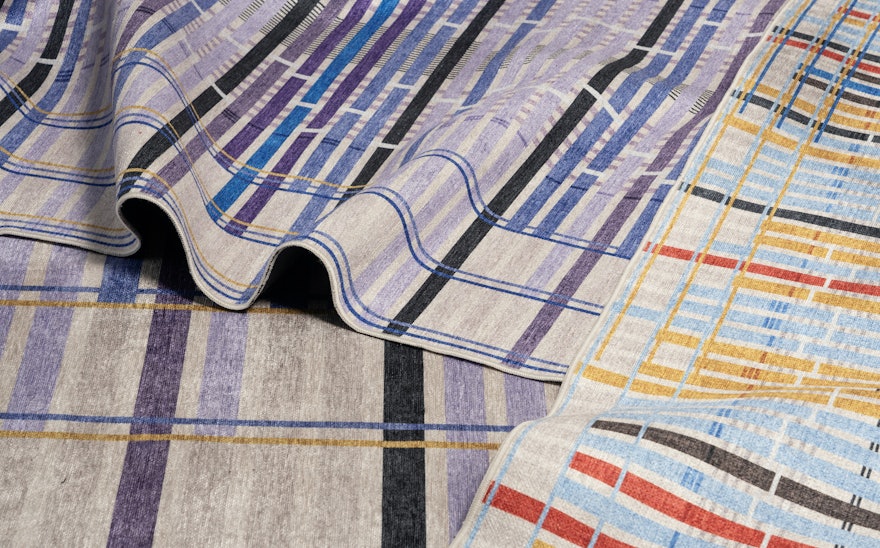Pentagram Partner Giorgia Lupi has created a new series of rugs for Well Woven, the innovative rug manufacturer. Called “Unraveling Stories,” the collection uses the colorful patterns of information design and data visualization to highlight lost and endangered textile techniques from around the world.
Available in four different sizes and two color patterns, the rugs feature a structure of horizontal and vertical bars representing data from 59 distinct textile techniques and fiber traditions. An information key is provided on the tags on the back of the rugs. The design also alludes to the geometric nature of the loom and the aesthetics of the modernist textile designer Anni Albers, who made innovations in the field of functional materials and distinctive style.
The project is the latest in a series of collaborations between Well Woven and various artists and brands. Giorgia, who received the 2022 National Design Award for Communication Design, is a proponent for “data humanism,” or using data to uncover the human stories behind the numbers and statistics.
Textiles have always been an integral part of human civilization, from the ceremonial to the utilitarian to the domestic. But today, people are more disconnected from the craft and tradition of textiles than ever, and many of the traditional ways of producing, using, and understanding textiles have been lost — or are in danger of disappearing.
"I love working on data art that people will get to actually interact with on a daily basis," says Giorgia. "Bringing a data-driven rug into your home infuses your space with the story contained within that data represented in that rug. I see the world through a lens of data, so I am always pleased when I can help data stories play a small part in the lives of others. The collaboration with Well Woven was incredibly exciting!”
“We’re delighted to bring these unique perspectives to life, paying homage to classical textile crafts and working with Pentagram and Giorgia Lupi,” says Adem Ogunc, CEO of Well Woven. “Inspired by Anni Albers’ style, we believe these rugs are not just decorative pieces, but pieces of history to own. It’s been a joy collaborating with Lupi and her team. I’m particularly captivated by the clean, modern lines and intricate details, as well as the underlying messaging that each piece carries.”
To develop the collection, Giorgia and her team researched the rich history of global textile traditions, learning that many of these diverse techniques are actually quite endangered or have already been lost to time. Like the environment and wildlife, craft traditions and heritage are threatened by numerous environmental and economic forces, from famine and war to migration and climate change.
The team cast a wide net with their research, digging into everything from the documentation of hyper-local loom weaving to scientific efforts to re-grow extinct flax fibers. Along the way, they discovered numerous attempts to safeguard endangered techniques, raise awareness, and preserve traditional ways of making, understanding, and relating to textiles, from international government initiatives to academic research to photojournalism. Much of the data came from UNESCO, who maintain a register of endangered culture dubbed the list of “List of Intangible Cultural Heritage,” as well as other individual researchers and activists.
The team assembled a data archive over months to build a design that could function simultaneously as an in-depth data visualization and as a day-to-day element in any household. The final design celebrates and catalogs 59 diverse textile traditions dating back thousands of years, builds awareness of the forces that threaten them, and allows Well Woven’s customers to bring the whole story into their home.
Reading the rug, customers get a high-level sense of the variety and strength of the forces that threaten these 59 textile techniques, indicated through the color and size of the main vertical bars. A deeper read into each bar provides more context about each technique, including visualizations of age, country of origin, the types of fibers used, and the relative size of the final output.
Precise segmentation of color and shape allows numerous layers of data and information to coexist, and enable a bi-directional readability of individual techniques across time, and across other specific metrics.
Organizing these traditions as vertical bars in chronological order, the timeline’s overall visual form is determined by data points for each individual technique, with changes in color, size, and pattern indicating a textile tradition's threat level — how endangered it is — as well as its background — place of origin, age, fiber composition, size, and more. The result is a collection of legible data portraits that collapses the space between abstract furnishing and rich information graphics.
The collection will be available to order online at wellwoven.com.

